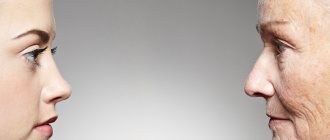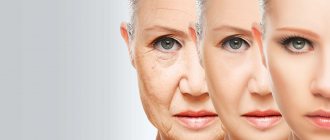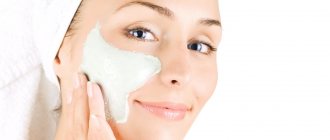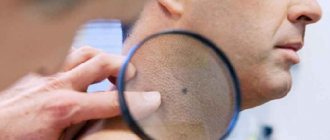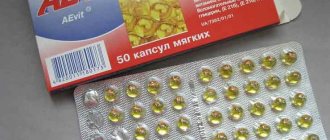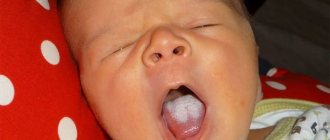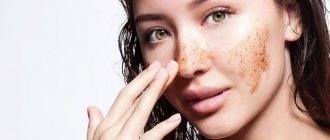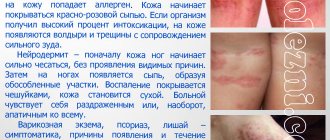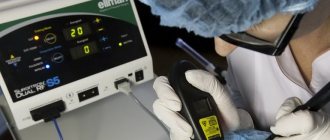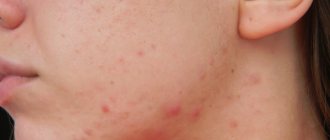We'll tell you what to do if you have this problem.
Enlarged pores—small holes in the skin that release oil and sweat—may seem like a teen problem, but they're actually one of the hidden signs of aging skin.
The bad news: You can't change the number of pores you have or their natural size, which is determined genetically and can get larger over the years. “Collagen, which strengthens pore walls to make them appear tighter, breaks down as we age,” explains Shari Marchbein, MD, a dermatologist in New York City.
Good news: There are solutions to reduce their appearance (and give you a more youthful-looking face), from quick-acting pore-enhancing treatments to in-office pore therapy.
What happens to the skin with age - the main signs.
Over the years, wrinkles, creases, age spots and other traces of the years appear on the face; they can be divided into: mandatory and secondary (possible). Regardless of the type of skin aging, secondary signs should be prevented and mandatory ones should be minimized.
- The appearance of wrinkles.
- Oval deformation is most pronounced in the deformation type of facial aging.
- Decreased turgor and elasticity.
- The appearance of dry skin is most pronounced with the finely wrinkled type of aging of the facial skin.
- Thinning.
The secondary (possible) include:
- Pastosity (swelling), impaired fluid distribution. Stagnation of fluid and lymph. Characteristic of the tired type of aging facial skin.
- Skin porosity may result from increasing age-related dryness.
- Looseness, laxity and sagging skin
- Deterioration in the quality of blood vessels, loss of elasticity, increase in their fragility. Poor circulation in the upper layers of the skin.
- Age-related skin pigmentation.
These minor signs can be minimized with proper care. For example, with regular skin moisturizing, strengthening the lipid barrier, and correcting age spots. We have named not all minor age-related signs, but the most common ones.
You can read more about anti-aging care (proper moisturizing or lightening age-related pigmentation) in the articles in the Anti-aging skin care section of the blog.
Mandatory and possible signs are due to the following types of facial skin aging.
- Chronoaging.
- Photoaging.
- Hormonal aging.
Anti-aging skin care
It is advisable to carry out anti-aging care taking into account the type of facial aging.
Facial care, which refers to the tired type of aging, involves modeling facial contours and filling wrinkles with fillers based on hyaluronic acid. All types of hardware procedures aimed at increasing muscle tone are suitable. It is extremely important to saturate the body with antioxidants and vitamins that will nourish the skin from the inside. The biorevitalization procedure, as well as mesotherapy, will help tighten the face, and a tonic massage will improve skin turgor. Suitable for vacuum facial cleansing and laser resurfacing.
Suitable cosmetics for this type are:
- active serums and masks that replenish the energy potential of skin cells;
- cosmetic preparations enriched with antioxidants and vitamin complexes aimed at combating free radicals;
- restorative oil compositions and creams with a moisturizing and nourishing effect to eliminate dry skin.
The finely wrinkled morphotype is suitable for procedures such as biorevitalization, various peelings, Botox, mesothreads, as well as contour plastic surgery.
It is preferable to choose the following as cosmetics:
- intensively moisturizing creams and serums;
- agents that stimulate cellular renewal and metabolic processes;
- creams, oils and serums enriched with antioxidants.
People with deformation type of facial aging should pay attention to all kinds of laser rejuvenation technologies and peelings, myostimulation to improve muscle tone, face building, plastic surgery and sculptural massage.
As cosmetics, preference is given to:
- products that activate the production of your own collagen and have a lifting effect;
- serums with high retinol content.
People with a muscular morphotype of facial aging should pay attention to mesotherapy, microcurrent and ultrasound therapy, laser rejuvenation, procedures that stimulate the production of hyaluronic acid, elastin and collagen.
For skin care products, you should choose those that are enriched with vitamin C and retinol. It is also worth paying attention to moisturizing and Korean cosmetics, ideal for this type of facial aging.
For the combined type of facial aging, care is suitable, including chemical peels, laser procedures for facial rejuvenation, face-building and sculpting massage, biorevitalization and various types of mesotherapy.
Chronological aging.
Quite a few theories have been created to explain aging. But there is no one that gives answers to all questions. In this article we will mention only one, which explains age-related changes in the body, including in the skin. This theory is the most accepted.
The theory of free radicals (according to some estimates, up to 90% of negative processes are caused by the activity of these particles). The theory is that free radicals produced in our bodies attack and damage cells. As a result of this attack, cross-links appear in the collagen fibers, which deteriorate the structure of the extracellular matrix, which is the cause of wrinkles. With any type of facial skin aging, free radicals cause the following problems:
- provoke pigmentation,
- can cause various inflammations (acne, rosacea, dermatitis),
- cause dryness and dehydration,
- can cause DNA mutations.
Antioxidants act as protectors and saviors of cells. Currently, antioxidants are used as active cosmetic components and are included in cosmetic compositions for skin care for various types of facial aging.
You can read more about free radicals and our protectors in the article about antioxidants for the skin. The appearance of free radicals in the body is caused by many factors, including bad habits. Therefore, healthy and beautiful skin is not only anti-aging cosmetics, but also a healthy lifestyle.
You can choose cosmeceuticals with antioxidants in the section – Cosmetics with antioxidants.
The problem of oxidative stress is so relevant in facial skin care that some brands conceptually define the need for antioxidants, for example Renophase.
How to prevent rapid skin aging - eliminate the causes of early wrinkles
- Don't squint
- Do not support your face with your hand or fist
- Don't rub your face with your hands. Control yourself while washing: your movements should be light and gentle. Apply the cream with your ring fingers, as they are the weakest and will not harm your skin.
- Watch your facial expressions. Over the years, you need to learn to grimace less. Otherwise, deep wrinkle furrows will soon appear in places of greatest facial activity.
- Stop smoking and drinking alcohol.
- Eat right. Start baking your usual foods. Give up all harmful foods in favor of fruits, vegetables, berries and nuts - these are real defenders of youth and health, neutralizing any signs of rapid skin aging. The reason for their usefulness and effectiveness is that they contain a huge amount of vitamins and minerals that are necessary to nourish, moisturize and accelerate metabolic processes in the skin.
- Play sports. Choose the most enjoyable form of physical activity for yourself. This could be a daily run. By the way, it is during jogging that the body is saturated with oxygen, blood circulation increases, which helps remove toxins from the body, moisturize the skin and produce collagen.
Hormonal aging.
Menopausal (hormonal) aging is caused by an insufficient amount of estrogen in the blood. To put it simply and briefly, the epidermis and fibroblasts of the dermis have estrogen receptors. Therefore, a decrease in the content of this hormone affects the quality of the skin and the intensity of age-related changes, regardless of the types of facial aging.
To compensate for the decrease in your own estrogens, cosmetic formulas may contain phytoestrogens, as in some products from the Renophase brand. The phytoestrogens used are diosgenin and genistein. The following are anti-aging cosmetics containing phytoestrogens.
Regenerating cream H+ Comblement. Application effect – Anti-age/Regenerating/Moisturizing. The cream contains: phytoestrogens, glycerin and glycosaminoglycans as moisturizers, as well as lecithin, a building material for cell membranes.
Renulift cream. Effect of application – Anti-age/Lifting/Moisturizing. In addition to phytoestrogens, it contains a complex of humectants - hyaluronic acid, urea, glycerin, which helps improve the quality of the natural moisturizing factor.
Serum Renulift. Application effect – Anti-age/Boto effect/Lifting. The anti-aging effect of phytoestrogens is complemented by the action of peptides included in the serum.
Renupil mask. Effect of application – Anti-age/Moisturizing. The composition includes acids: citric, lactic and glycolic. Stimulate the renewal of the epidermis, enhance the rejuvenating effect of phytoestrogens.
Regenerating serum H + Regenerant. Effect of application – Anti-age/Moisturizing. The composition is enhanced by a multifunctional asset with a proven reputation - vitamin C.
Photoaging.
During photoaging, negative processes occurring in the skin are caused by exposure to UV radiation, especially exposure to UVA rays that reach the dermis. Regardless of the type of facial skin aging, the following changes occur under the influence of photoaging factors:
- the stratum corneum thickens
- signs of atypia appear (factors that distinguish a normal cell from a cancerous one),
- collagen fibers are disorganized,
- defective elastin is synthesized (which is scientifically called elastosis),
- Vascular mesh and pigmentation appear.
You can read more about photoaging, UVA and UVB rays in the article - Photoaging of the skin.
Photo-, chrono- and hormonal aging lead to the following problems.
- Thinning of the epidermis and dermis.
- Deterioration of the skin barrier.
- Degradation of the structure of the extracellular matrix - a decrease in the quantity and deterioration in the quality of elastin, collagen fibers, as well as hyaluronic acid and other glycosaminoglycans.
- Deterioration of microcirculation.
Age-related changes are premature and natural.
Regardless of the types of facial skin aging, age-related changes can be divided into:
- natural,
- premature.
This is important because it helps you realize a very simple fact - cosmetic care and a healthy lifestyle really affect the speed and intensity of age-related changes.
Natural changes, i.e. in whom the above external signs of aging appear after 50 years.
Premature - signs of age appear before half a century has been lived.
The rate of skin aging is determined not only by genetics, but also by external (endogenous) factors. These include various diseases, UV radiation (photoaging), stress, poor lifestyle, improper cosmetic care or lack thereof.
Types of aging provide a general understanding of age-related changes, but this is not enough for choosing anti-aging cosmetics. Let's move on to consider the types of facial aging.
What are the main causes of skin aging?
Sharp aging of facial skin occurs due to a decrease in the synthesis of collagen and elastin. Collagen fibers thicken and become less elastic. The internal structure changes, there is less water in the intercellular space, due to this elasticity is lost and wrinkles appear.
Factors that influence facial skin aging:
- genetic factor;
- unhealthy lifestyle (nutrition, stress, illness, bad habits, skin care products and decorative cosmetics, external factors).
Types of facial skin aging, their characteristics, description.
Why is it important to know your aging type? Depending on this, the appropriate anti-aging care will be selected. Therefore, correctly determining your type is the first step to choosing funds.
At first glance, and you don’t need to be a cosmetologist for this, you can see two extremes with age-related changes, this is a deformation change in the contours and skin (the extreme picture on the right), the other extreme is drying out (the picture on the left). The paintings look gloomy, but accurately convey the image of the types of aging. But such a classification is good, perhaps for artists for whom the expressiveness of nature is very important.
Types of aging, from left to right - finely wrinkled, tired face, deformed (largely wrinkled).
For care purposes, it is better to use the classification according to I.I. Kolgunenko (Doctor of Medical Sciences, Professor). According to which there are 5 types of facial skin aging.
- Finely wrinkled.
- Type of aging - Tired face.
- Deformation (large wrinkled) type of aging.
- Muscular.
- Combined.
Depending on the specific morphotype, age-related changes manifest themselves through changes in the structures listed below.
- Subcutaneous fat tissue.
- Facial muscles.
- Epidermis and dermis.
Types of facial aging and anatomical parts of the face that determine the “portrait” of aging.
| Aging type | finely wrinkled | Tired face | Deformation (large wrinkled) | Muscular |
| Anatomical parts that define the aging portrait | Epidermis and dermis | Epidermis and dermis + subcutaneous fat (weakly expressed) | Subcutaneous fat (highly expressed) | Facial muscles |
IMPORTANT!
These three structures are important for understanding what is possible and what is quite difficult to do at home for anti-aging care. The most accessible arsenal in home care is gymnastics, massage, anti-aging cosmetics that are aimed at improving facial muscles, as well as improving the structure of the epidermis and dermis. It must be admitted that only the use of anti-aging cosmetics may not be enough; at a minimum, care should be supplemented with muscle exercises and facial massage.
How can you slow down skin aging?
- balanced diet;
- proper use of cosmetics;
- personal cosmetologist;
- protection from adverse environmental factors, especially from the sun;
- relaxation system for the whole body;
- sleep at least 8 hours, in the correct position relative to the face and body;
- rest and walks in the fresh air;
- fitness and aerobic exercises;
- massage and hygiene care at home.
Type of aging – Tired face.
A “tired face” is typical for those with thin or medium-thick skin, with an average volume of subcutaneous fat, and a normal or thin build. Of all the types, it is the most responsive for anti-age care.
The hallmarks of this type of aging include:
- Pastiness, swelling.
- Drooping of the corners of the lips and eyes.
- Clearly defined nasolabial folds.
- Wrinkles in the upper part of the face may be mild.
- The infraorbital and/or buccal-zygomatic groove is often prominent.
It is important that the “tired face” retains the oval, it does not have jowls and multiple changes in the contour configuration. It seems that to eliminate all these imperfections it is enough to have a good rest and sleep.
For a “Tired Face,” first of all, signs of age-related changes are determined by fluid stagnation and the appearance of swelling. In addition to them, muscle tone and turgor may decrease.
What to do in care for the tired type.
First of all, you need to focus on lymphatic drainage care. This could be massage, facial gymnastics or hardware techniques - mesotherapy with lymphatic drainage effect. Home care uses care products with a lifting effect, moisturizing and nourishing creams.
Deformation, large-wrinkled type of aging.
Women with the following symptoms are predisposed to these age-related changes.
- Dense, well-developed layer of subcutaneous fat, full face.
- Tendency to swelling. Swelling is a consequence not only of fatigue, dietary habits (herring at night) or any disease. In addition, there is a genetic predisposition to edema, due to the quality of the vascular walls.
Both swelling and a significant layer of fatty tissue contribute to ptosis, one of the satellites of the deformation type of aging of the facial skin. The result is changed contours, a heavy, swollen face.
These signs are the main ones, the rest, such as oily skin or a predisposition to obesity, are not decisive.
The deformation is primarily characterized by a violation of the oval configuration. This happens almost everywhere, so a more accurate definition is multiple configuration violations. But this is most pronounced in the lower third of the face. This is the key difference between deformation and other types and, above all, from the “tired face”.
The portrait of the deformation type of facial aging is made up of the visual imperfections listed below.
- Double chin.
- Puppet wrinkles
- They shaved.
- Changing contours, the oval changes.
- Drooping upper eyelids, lower eyelid hernia.
The general condition can be characterized by the phrase – the face looks heavy and swollen
All these imperfections are determined by a combination of the following factors.
Impaired lymph outflow + gravitational downward displacement of subcutaneous fat tissue + changes in muscle tone + age-related changes in the structure of the muscular aponeurotic complex (the muscle layer located under the subcutaneous fat tissue and including the superficial facial muscles).
This type of facial skin aging presents the greatest difficulty in anti-age care.
What to do in care for deformation type.
Key points in care. If the main reasons for the floating contour are: swelling, a significant layer of fatty tissue and loss of muscle tone. Therefore, anti-aging care should focus on the following effects.
- Lymphatic drainage
- Various lipolysis procedures in areas of fat accumulation.
- Procedures aimed at restoring muscle tone
- The use of decongestant care products, products that improve microcirculation and improve the quality of blood vessels and capillaries.
- Lifting effect.
The peculiarity of this particular type of skin aging is that anti-aging care must be understood in a broad sense. These are not just local cosmetic procedures. This is, first of all, an appropriate lifestyle (without extra pounds), complemented by non-cosmetic anti-age care. For example, massage and gymnastics for facial muscles.
You need to change your habits, get rid of bad ones, and supplement your lifestyle with proper cosmetic care. And then, your reflection in the mirror will not resemble the portrait described above, called the deformation type.
Choose a mask that suits your skin type
They're not just a good way to relax, face masks can also tighten your pores over time. “Home treatments such as facials and peels work with consistent long-term use,” says Dr. Imajierobo-Ip. Incorporate once or twice a week into your beauty routine. If you have large pores and oily skin, masks containing ingredients like clay or charcoal will work best for you.
For other skin types, "multitasking" by applying these formulas to the T-zone (forehead, nose and chin), where pores tend to be most visible, is best.
Finely wrinkled type of facial skin aging.
Main features.
- Many small wrinkles that remain at rest. Wrinkles in the forehead, eyes (crow's feet), around the lips.
- Dry skin.
The general condition can be described in one word - drying out.
In a sense, this is the opposite of strain aging. The face, due to the finely wrinkled type of aging, does not have significant subcutaneous fat. External signs of age are primarily determined by the structure of the skin, the quality of the lipid barrier and, to a lesser extent, swelling and fat deposits. The main changes occur in the epidermis and dermis. The oval remains for quite a long time, there is no ptosis.
The main reasons determining fine wrinkled aging.
- Skin dehydration.
- Deterioration in the quality of the lipid barrier.
- Deterioration of the structure of the extracellular matrix (fragmentation of collagen and elastin).
Anti-aging care for this type is simpler compared to deformation care.
What to do in care for fine-wrinkled type of facial aging.
Since the main age-related deficiencies are concentrated in the epidermis and dermis, the emphasis will be on these structures. What is your skin missing? First of all, efforts must be directed towards tissue hydration. To moisturize, it is necessary to use anti-aging cosmetics containing the following active ingredients - aloe vera, glycerin, urea, hyaluronic acid, chitosan, hydrolyzed collagen.
It is also necessary to include products that strengthen the lipid barrier of the skin, including products containing oils. Why aren't the oils in their pure form? You can read about this in our blog articles.
To normalize keratinization, peelings or products containing acids can be included in the care program.
Peeling is undoubtedly the most effective anti-aging procedure. But, in terms of care for the fine-wrinkle type of aging, you need to take into account the characteristics of the skin. If the skin is dry, then peelings should be used with caution, due to the high sensitivity of this skin type to external irritations.
The finely wrinkled type also includes expression wrinkles, which can be corrected by using products with a peptide-based boto effect. Peptides are effective fighters against age-related changes. They directly interact with skin cells, eliminating not the effect, but the cause.
You can read about various cosmetic assets: oils, acids, peptides and other assistants in facial care in the articles on our blog.
Skin dehydration
Lethargy, decreased elasticity and firmness of tissues are largely due to a decrease in water content in them. Signs of “withering” skin, regardless of the type of facial aging, begin to appear after 25-30 years and long precede the formation of the first fine wrinkles. This is due to damage to the lipid membrane of the epidermal layer, which protects the skin from excessive moisture loss, by detergents, lotions, UV rays, etc. and its gradual thinning.
It covers the stratum corneum and, in turn, consists of several layers interconnected by vitamin “F”, which is a complex of essential fatty acids - linoleic, linolenic and arachidonic. Some of them come from food, others are synthesized in the body.
At a young age, the lipid layer is quickly restored after destruction, but at an older age this process takes a longer time. This is explained by age-related deficiency of enzymes in the body and, accordingly, deficiency of vitamin “F”. Slow restoration of the lipid barrier facilitates easier penetration of damaging substances and further destruction of the lipid layer of the epidermis.
Restoring skin balance is facilitated by cosmetics with components containing essential fatty acids (evening primrose, borage and black currant seed oil, other vegetable oils), mesotherapy with hyaluronic acid and a complex of vitamins, injection and laser biorevitalization and other procedures.
Free radicals and antioxidants
Free radicals are active atoms and molecules lacking one electron in their outer orbit. Most of them are characterized by high reactivity, that is, they have high oxidizing ability. By attaching a second electron to themselves from atoms of other chemical elements, free radicals become neutral and lose activity, but the first ones are oxidized and also turn into free radicals. This is how a vicious circle is formed. The main place of formation of free radical groups is the mitochondria of cells, resulting in a violation of the intracellular energy balance.
For example, as a result of the effect of free oxygen radicals on the molecules of collagen proteins, the latter, previously neutral, become overactive, bind (crosslink) with each other and become less elastic, which contributes to the formation of wrinkles. The influence of free radicals on the enzyme system of cells causes disruption of biochemical reactions in them, and the transformation of DNA molecules into radicals leads to malignant growth or cell death.
A particularly dangerous process is peroxidation, which occurs as a chain reaction, as a result of which not only free radicals are formed directly, but also lipid peroxides that are part of the cell membrane and are easily converted into many new free radicals. Their number grows like an avalanche and easily reacts with proteins, new lipids, and cellular DNA.
The weakening and slowing down of these reactions and the restoration of already oxidized compounds occurs thanks to antioxidants that block free radical oxidation. These include vitamins “E”, “C”, “K”, ubiquinone (vitamin “Q”), glutathione (a peptide consisting of 3 amino acids), sulfur-containing elements, tocopherols, carotenoids, estrogens, some protein and amino acid complexes , as well as trace elements (selenium), antioxidant enzymes (superoxide dismutase, catalase, glutathione peroxidase) and many other compounds in the body.
For example, vitamin “C” is necessary to restore vitamin “E”, and glutathione is necessary for vitamin “C”; superoxide dismutase, in interaction with catalase, neutralizes oxygen free radicals and prevents the process of oxidative chain reaction, and glutathione peroxidase, the activation of which requires selenium, neutralizes the resulting lipid peroxides.
Adequate blood circulation and lymphatic drainage ensure timely delivery of antioxidants to tissues and removal of metabolic breakdown products from free radicals.
Negative exogenous and endogenous factors enhance and accelerate the formation of free radical compounds, which leads to an overload of the natural antioxidant defense system and, as a result, to “oxidative stress” in the body and accelerated aging of its tissues.
That is why proper nutrition, rich in vitamins, biologically active substances and microelements, the normal functioning of all body systems, and proper facial care is important.
Watch a video about 6 types of facial aging:
Ultraviolet radiation
Small doses and gradual tanning are necessary: they play a major role in the formation of vitamin “D” in the body and in calcium metabolism, in strengthening the immune system, have a beneficial effect on the psycho-emotional state, lead to a thickening of the stratum corneum and the formation of pigment that protects underlying tissues from negative external influence.
But an excessive dose of ultraviolet rays:
- has a damaging effect;
- changes the rate of cell division, which leads to uneven growth and the appearance of atypical cells;
- promotes the formation of free radicals in the skin;
- activates the enzyme tyrosinase, which leads to an increase in melanin synthesis, the size of pigment cells (melanocytes), elongation and branching of their processes, and the appearance of age spots;
- reduces the elasticity of the walls of small vessels (“stars” and “meshes”).
- changes the rate of enzymatic reactions in cells and intercellular substance, which includes collagen fibers; These changes are uneven in nature - along with normal collagen fibers, shapeless atypical elastin accumulations appear.
All of these changes are called signs of photoaging. But unlike true aging, in which the skin layers become thin, the epidermis and stratum corneum thicken during photoaging. Partly for this reason, they are partially reversible and can be largely corrected through peeling procedures using alpha hydroxy acids and retinoic acid, which also stimulate the synthesis of collagen and elastin. The use of products with UV filters, the use of clothing, and limiting exposure to open sunlight can prevent or reduce the negative effects of UV rays.
Muscular type of facial aging.
This type is characterized by deep wrinkles in the corners of the mouth and on the forehead; also, over the years, the severity of nasolabial folds increases
This type of skin aging is characteristic of those people whose subcutaneous fat volume is not developed, in contrast to developed facial muscles. For a relatively long time, facial muscles act as a reliable framework that “supports” the face and gives it a youthful appearance. There are not many fine wrinkles, and the oval shape of the face remains until old age.
What to do in caring for the muscular type.
The key factor is hyper and hypotonicity of the facial muscles (in other words, imbalanced tone), so the emphasis in care is on botulinum therapy, which should be accompanied by mesotherapy and biorevitalization. And of course, don’t forget about facial gymnastics, because the condition of the muscles in this case is decisive; it’s not for nothing that we compared the muscles to a frame that “supports” the face.
Combined type of skin aging.
Combined aging, to a greater or lesser extent, combines all of the listed types. Anti-aging care is aimed at correcting the external signs of the most prevalent types of aging and, in its essence, is also combined. This portrait of age-related changes is the most common.
So, all these age-related imperfections corresponding to a certain type of aging, to one degree or another, can be corrected with the help of anti-aging cosmetics, gymnastics and facial massage.
Combined (mixed)
From the name it follows that such aging is characterized by a mixture of characteristics from different types. It occurs in people with combination skin, normal build and a tendency to swelling. It appears in many people of the European race.
Often combined aging begins in the same way as fatigued aging. Wrinkles appear in areas with dry skin, and the oval of the face changes in the cheek area. It begins to appear after 40 years, especially in women - during hormonal changes in the body.
What to do for rejuvenation:
- combined care: different products are applied to dry and oily skin;
- rely on recommendations from other types of aging, monitor yourself and regulate care and cosmetic procedures.
Objectives of anti-aging care. Review of anti-aging cosmetics. Anti-aging complexes.
At the beginning of the article, it was not by chance that we classified aging:
- according to mandatory and secondary criteria,
- as natural and premature,
- by types and types.
Now we have an algorithm for anti-aging care, where there is a place not only for cosmetics, but also for other significant influencing factors - gymnastics, facial massage and a healthy lifestyle.
The main objectives of anti-aging care can be formulated as follows.
- Minimize the manifestation of obligatory signs of age-related changes - YES, IT IS POSSIBLE,
- Prevent the appearance of possible signs of aging - YES, IT IS POSSIBLE,
- Prevent premature aging – YES, IT IS POSSIBLE.
Anti-aging care products can be selected in the section - Anti-aging facial cosmetics or in the Obagi Sets section.
